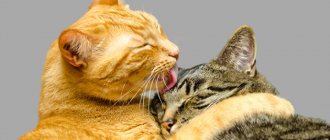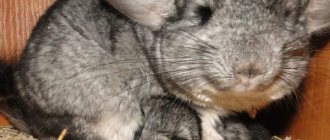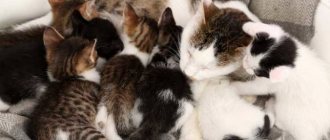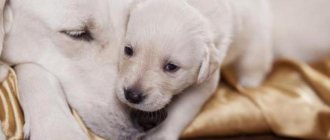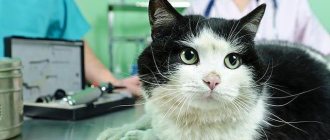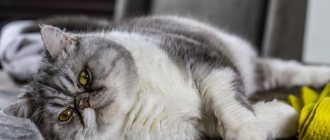Pregnant cat
Cat owners sooner or later face a situation when their pet, having reached physiological maturity, is preparing to have offspring. The only exceptions can be cases when the cat has been sterilized or has completely excluded contact with the opposite sex. Anticipation of the upcoming appearance of kittens is very exciting for owners. Therefore, it is advisable to find out about the upcoming event as soon as possible.
In the article, we talked about how to understand that a cat is pregnant, what signs indicate this, and diagnostic options. You will also learn the peculiarities of the first pregnancy and the peculiarities of caring for a cat.
Why detect a cat's pregnancy in the early stages?
Despite the fact that a cat's body is designed to survive in the wild, care and monitoring of pregnancy are very important. The sooner the owner finds out that she is pregnant, the more time she will have to prepare for the arrival of the babies. For your information! The ability to bear kittens occurs at different ages in each breed. For example, British cats are ready for their first pregnancy only after 1 year of life. It is especially important to monitor the condition of purebred animals (for example, sphinxes, folds). Some breeds may have difficulties during pregnancy and birth. In addition to being monitored by a veterinarian, owners must be able to independently handle the cat during labor if assistance is needed.
I am pregnant?? - Can't be…
At what stage can pregnancy be determined?
At home, recognizing your pet's pregnancy is a difficult task. So, how do you know if your cat is pregnant?
You can visually recognize a cat’s pregnancy only by the animal’s changed behavior. A month after fertilization, the sides of the abdomen and swollen nipples become noticeable. You can find out about pregnancy in the early stages from your veterinarian. In hospital settings, ultrasound is performed starting from the 20th day after fertilization. At 25 days, an analysis is done at the veterinary clinic, and after 26-30 days, the doctor palpates the abdomen to determine the presence of a fetus. Another way is an x-ray, but it can be done starting from the 40th day.
Ultrasound is an accurate method for determining pregnancy
How do you know if your cat is pregnant?
A cat's pregnancy can be recognized by changes in behavior, and a veterinarian will help to accurately determine the fact of pregnancy. Around the 21st day after conception, he can feel if there is a fetus in the uterus.
However, there are symptoms that will tell you that your cat will soon have kittens: changes in the mammary glands, fatigue, toxicosis and more frequent urination are all signs that your cat is expecting offspring.
Changes in the mammary glands
This symptom usually accompanies the first pregnancy in cats. The duration of uncharacteristic behavior for a cat can vary, so you may not think anything of it at first, but redness and swelling of the nipples should alert you. If your nipples feel hot, your cat may be pregnant.
Fatigue
Drowsiness, lethargy, reluctance to run and frolic... Is this really the same cat that loves to play so much? Days of pregnancy can change your pet's behavior, and fatigue is one of the signs.
Toxicosis
Early pregnancy in cats can be accompanied by toxicosis. Nervousness, poor appetite, morning vomiting - toxicosis is unpleasant, but safe for the cat and its offspring. Make sure that these signs are not accompanied by diarrhea and dehydration - in this case, the cat should be shown to a veterinarian.
More frequent urination
During pregnancy, cats may empty their bladder more often than usual. If the urine is clean, free of blood, and the process of urination is painless and does not cause anxiety in the cat, then everything is in order with its health.
Accurate signs of pregnancy
After mating, the owner must carefully monitor the condition of the cat, since the appearance of uncharacteristic symptoms may indicate a pathology of pregnancy. In addition, intercourse sometimes does not lead to fertilization, resulting in the need for additional mating.
And here, all the owners are wondering: how can they understand that the cat is pregnant? The most informative signs of pregnancy include an increase in the size of the abdomen, changes in behavior, cessation of estrus and some other manifestations.
Estrus refers to the manifestation of the period of arousal in the sexual cycle. The processes accompanying this stage are aimed at changing both the behavior and the state of the cat’s reproductive tract, which will contribute to attracting a male and fertilization. Accordingly, in the case of successful conception, continuation of estrus is not advisable, so signs of arousal disappear - the vaginal mucosa loses hyperemia, the secretion stops being released from the loop.
The cat goes into heat
If estrus continues after mating, this indicates a failed pregnancy. If the lack of conception is confirmed, the breeder will have to resort to re-mating the female.
We will tell you the signs of pregnancy in a cat.
Changing nipples and belly
The earliest sign of pregnancy in a cat is a rounding of the abdomen due to an increase in the size of the uterus as a result of the growth of the fetus. The sign is usually detected after one month from the date of mating. The rate of growth of the abdomen, as well as its size, depend on the individual characteristics of the female, the number and size of the offspring. During this period, the first movement can be determined by palpation. To do this, carefully palpate the lateral sections of the abdomen.
Changes in nipple pigmentation begin in the first days after conception. The color becomes brighter, they acquire the maximum pink tint in the last stages. The greatest change in color is typical during a cat's first pregnancy. As delivery approaches, the nipples swell, which is a preparation for breastfeeding the offspring. Such changes are caused by the action of hormones.
Nipple enlargement
The first release of milk, or rather colostrum, occurs approximately seven days before the kittens are born. The secreted substance contains a large amount of protein and fat, and subsequently its composition changes somewhat.
Changes in appetite
To answer the question of how to determine if a cat is pregnant, you need to monitor your pet’s behavior. In the first weeks after mating, the animal's appetite rarely decreases. Sometimes vomiting is observed in the morning. Unfortunately, vomiting can be the cause of many diseases, in particular worms. Therefore, if this sign is present, it is advisable not to delay and take the cat to the veterinarian. From the middle of pregnancy, the appetite grows rapidly, so during the process of bearing kittens, a cat can gain up to 3 kg.
The cat has a good appetite
Change in Behavior
A possible pregnancy can be determined by changes in the animal's character and behavior. At first, the cat behaves slightly aggressively. From the second half of gestation of kittens, the cat’s behavior changes in the opposite direction. She looks affectionate and gentle, and tries to spend most of her time with her owner.
At the same time, the animal eagerly makes contact with its owners, asks to be petted and climbs into their arms. There may be an increase in appetite - the animal constantly asks for food, and does this with great persistence. At 5–7 weeks, the kittens begin to move imperceptibly in the mother’s womb.
A couple of days before the kittens appear, the animal shows special care and attentiveness, starting to lick the owners or other inhabitants of the apartment in every possible way, showing concern for them.
Excessive affection appears in later stages
Drowsiness and apathy
The most common symptoms are increasing weakness and lethargy. An active cat becomes calmer, spends most of its time lying down, and loses interest in games. In phlegmatic pets, the signs are less noticeable. This condition is associated with the action of hormones.
The cat sleeps more, plays less
Changes in behavior
During the first weeks, aggression towards other cats may appear. The character changes in the second half of pregnancy. The cat becomes affectionate and tender. The last stage is accompanied by apathy. Most of the time is spent at home, even if there is the possibility of free walking.
Pregnant cat prefers sleep at home to walks
Breeders note that there are no special, pronounced changes in habits during almost the entire pregnancy. The exception is the time before childbirth. The expectant mother begins to look for a secluded corner, to “nest”, and wants the owners to comfort her.
Diagnosis of pregnancy
Formally, ovulation occurs 24-30 hours after mating. For convenience, breeders calculate the total cycle length as the difference between the day of birth and the day of mating. On average, gestation of kittens lasts 62-68 days. The longest period is typical for the Siamese-Oriental group. These cats have offspring only 71 days after mating. How to determine if a cat is pregnant?
An earlier and more accurate diagnosis of a cat’s pregnancy can be done in the clinic using imaging studies:
- ultrasonography
- radiographic examination
Ultrasound can reliably diagnose a cat's pregnancy from the 20th day, and this method also allows you to monitor the development of the fetus throughout the pregnancy. The only parameter that is often impossible to determine using this type of study is the number of fetuses, especially in multiple pregnancies. The second method of visual diagnosis is radiography. This study is relevant no earlier than 4-5 weeks, since until this moment the bones of the fetus contain a small amount of minerals and are poorly visualized on an x-ray.
The most accurate method for determining pregnancy
X-ray allows you to confirm a cat’s pregnancy if it is not possible to conduct an ultrasound examination (there is no equipment in the clinics closest to you) and palpation is difficult (for example, the animal is aggressive or very obese). Also, using an x-ray, you can more accurately calculate the number of fetuses.
Pregnancy screening for cats
A veterinarian should check to see if your cat is pregnant. When examining cats, an assistant should hold the animal in a lying position. To do this, take the fold of skin near the back of the head with the right hand, and with the left hand grab both hind limbs in the metatarsal area, place the cat on the table and stretch it slightly so that it cannot squirm and scratch with the forelimbs or bite. The cat is held in a dorsal position and palpated through the abdominal wall with one hand.
For palpation, grasp the abdominal wall between the thumb and other fingers at the level of the lumbar vertebrae and gently squeeze the fingers. The rectum is often palpated here if it is filled with feces. Trying not to weaken the pressure of the fingers, move them down. At the same time, in non-pregnant cats, uterine horns are sometimes found, diverging in the form of elastic cords. In pregnant cats, uterine ampoules or fetuses are found.
Palpation by a veterinarian
Features of the first pregnancy
A pet can become pregnant immediately after the onset of the first heat - at 7-8 months. At this age, the body is formed for fertilization, but is not yet ready for safe bearing of offspring. Because of this, mating is carried out only on the third heat.
- The arousal stage corresponds to the period of maximum readiness of the animal for conception. Changes in the genital organs occur under the influence of gonadotropic hormones. In this case, the appearance of estrus is observed, which is characterized by swelling, edema and hyperemia of the vulva, and the release of mucus from the loop. Sexual arousal is accompanied by a change in the pet’s behavior - the cat becomes restless, active, and its appetite decreases. Next, the heat stage is formed, which is characterized by the female’s readiness to mate; at this moment she looks active and restless. Ovulation is the release of a mature follicle. This process in cats has its own peculiarity - the mechanism starts only after sexual intercourse after 1-2 days.
- The period of inhibition indicates a decrease in sexual activity. At this moment, the cat’s estrus ends: the mucous membranes of the genital tract return to their normal state, and the secretion of mucous secretion stops.
- The balancing period is characterized by the restoration of the cat's behavior and lack of attraction to males.
A cat can become pregnant immediately after the first heat, but it is best to breed at the age of 1.5 years
Young animals are bred at approximately 1.5 years. This reduces the risk of miscarriages and the birth of kittens with serious pathologies. If your furry pet becomes pregnant for the first time, then all the symptoms are more pronounced.
The safety of mating decreases after 6 years. At this age, breeding animals are sterilized. If you do not plan to breed the breed, sterilize your pet immediately after reaching maturity. This will reduce the risk of developing cancer to 0.5%.
A cat's first gestation is exciting for the owner. If a person can say what bothers him, then an animal cannot. Therefore, we do not always understand how this period proceeds, especially for the first time. The first and subsequent pregnancies last the same. The duration depends on the breed, emotional state, age, number of fruits. But the period should not be less than 60 days or more than 72 days.
Factors on which the period depends
How long a cat will walk while pregnant depends on many factors: its breed, age, condition, number of kittens, etc.
When can a cat become pregnant?
A cat is ready to become a mother for the first time at the age of 5 to 9 months, but this period may shift. There are many factors that influence an animal's reproductive process.
Body size, breed, general health and even the length of daylight hours all matter in one way or another. As a result, the age of a cat for the first pregnancy can vary from 3.5 (that is, pregnancy occurs even in small kittens) to 18 months.
Readiness to mate is expressed by peculiar behavior: the cat becomes very restless, constantly demands attention, may sleep less and eat worse. In addition, a characteristic pose appears when the cat falls on its front paws, arches its lower back, rolls on the floor and purrs or meows invitingly.
How to distinguish a false pregnancy from a real one
In some cases, indoor and outdoor cats suffer from false pregnancy. The causes of the pathology can be: sudden stress or emotional stress in the pet; mating with a sick cat; improper functioning of hormonal levels; being near a pregnant cat.
False pregnancy in cats
As a rule, the only way to determine whether an outdoor cat is pregnant is to see a veterinarian. Self-diagnosis is not informative due to the abundance of characteristic external signs.
Using an ultrasound, the cat's uterus is examined. The absence of kittens in the womb indicates the development of pathologies in the pet’s body. Treatment is prescribed depending on the cause and form of the disease. Therapy is often carried out using hormonal agents.
If you do not rush for an examination, you may notice the disappearance of symptoms without a trace after some time. Veterinarians do not recommend ignoring diagnosis in a veterinary clinic, since false pregnancy is not always safe.
What is the danger of false pregnancy?
Frequent false pregnancies have a negative impact on the physical and mental health of the pet, increasing the likelihood of developing oncology, endometritis, mastitis, pyometra and other diseases. If hormonal treatment is ineffective, the animal is sterilized.
It is best to contact a veterinary clinic to determine pregnancy
Pathologies during pregnancy in cats
Bearing kittens is a difficult period for the animal’s body, associated with serious hormonal changes and other changes. As the fetus develops in the womb, the load increases, the heart, hepatorenal system, digestive tract and respiratory system work harder.
In addition, bearing offspring is associated with various risks. A pregnant cat may experience vaginal discharge, which should not occur during the physiological course of pregnancy. In case of any deviations from the norm, you must contact a veterinary clinic for advice.
The most commonly diagnosed pregnancy pathologies are:
- inguinal hernia – characterized by protrusion of the uterus with the fetuses located in it into the area of the inguinal canal;
- bleeding in a pregnant cat - appears more often in cats with placental abruption;
- polyhydramnios – a large accumulation of amniotic fluid in the cavity (discovered in the last stages);
- uterine torsion – develops with mechanical damage to the uterus (impacts on the stomach during falls from a height);
- spontaneous abortion - the death of kittens in the womb with their further decomposition and removal from the cavity.
If blood appears in a pregnant cat, immediate contact with a veterinary clinic and intervention by a veterinarian is required. In addition, you should contact a specialist if the following symptoms appear in your pregnant pet:
- strong protrusions in the area of the last pair of milk bags (especially if this has not been observed before);
- yellow discharge from the genital opening;
- cat anxiety;
- severe weakness and apathy, complete refusal to eat;
- a sharp change in the shape and size of the expectant mother’s abdomen, swelling and hyperemia in the area of the loop;
- tension of the peritoneum, taking unnatural poses;
- miscarriage.
Depending on the diagnosed cause of the pathological changes, the veterinarian prescribes the most appropriate treatment. The owner’s task is to carefully monitor the pet’s condition and follow the doctor’s recommendations.
Features of caring for a cat in an interesting position
Pregnancy is a test for a cat’s body. Since all vital organs work in an intensive mode, the animal requires special care and attention. Favorable conditions play a big role in the course and outcome of the condition.
Diet and vitamins
In the first days of the appearance of increased appetite, the usual feeding rates are increased by 10%. In addition to the quantity of food, it is important to take care of its quality. To give birth to healthy offspring, your pet will need more vitamins and minerals. They can be obtained from super-premium and holistic-grade dry foods designed specifically for pregnant animals.
To change your eating habits you will need:
- Switch to easily digestible meals or special food. In the first case, the addition of vitamin and mineral supplements is mandatory, and in the second, it is discussed individually. Ask your veterinarian for exact dosages and brands.
- Increase the frequency of feedings. Do not try to feed an increased amount of food in 2 meals. Have 5-6 feedings per day. With the beginning of the second trimester, the amount of food should be increased by 2 times compared to the original.
- Change the water regularly. Do not forget to monitor the cleanliness and amount of liquid. Its deficiency or contamination with bacteria can lead to miscarriages.
Do not try to buy vitamins on the advice of friends and acquaintances. This is fraught with hypo- or vitamin deficiency.
During pregnancy, your cat should have a balanced diet.
